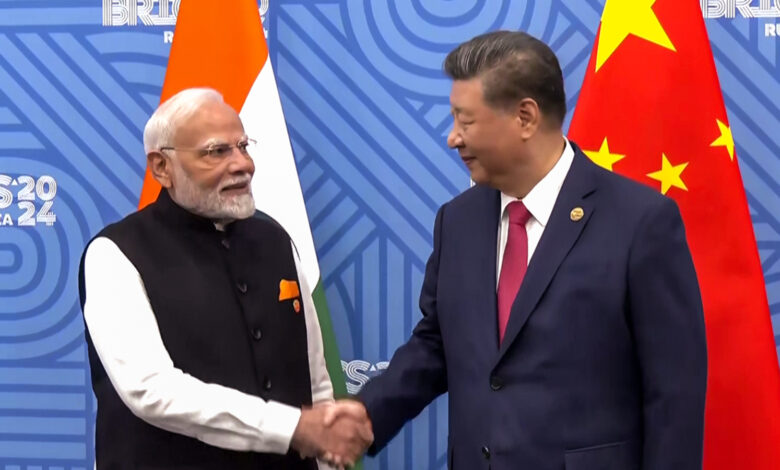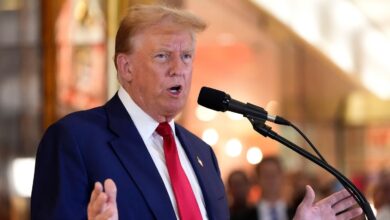“India, China Relationship Is.”: Beijing’s Message Following Trump’s 104% Tariff
China-India relations have been strained, to say the least, and hostile quite frequently, especially after Ladakh's Galwan Valley clashes in June 2020.

New Delhi:
Donald Trump’s tariffs are apparently accomplishing what decades of political and diplomatic maneuvering could not, at least with any significant measure of success – making India and China collaborate, to “make the dragon and elephant dance,” as Chinese Foreign Minister Wang Yi recently stated.
US President tariffs on China – currently at a breathtaking 104 per cent after Beijing hit back with a 34 per cent tariff during the first round – have ignited a second outright trade war between the two titans, as the Chinese declared they would battle “American aggression. to the end.”.
Trump’s tariffs, and the ensuing ‘game of chicken’ with China’s Xi Jinping, also seem to have prompted Beijing to issue a series of conciliatory comments regarding New Delhi; the most recent was Tuesday, when the Chinese Embassy urged India and China to “stand together to overcome difficulties“.
“Economic and trade ties between China-India are founded upon mutual interests. To counter the US’ tariff abuse, which robs nations, particularly those in the ‘Global South’, of their right to development, the greatest developing nations (in the region) must unite.” Spokesperson for the Embassy in Delhi Yu Jing stated on X.
The long post also appeared to hold a threat for Trump, informing the US President that “. trade and tariff wars have no winners. All countries should uphold the principle of extensive consultation, practice true multilateralism, (and) jointly oppose all forms of unilateralism and protectionism”.
The embassy also emphasized its role of strength regarding the international economy, highlighting that China accounts for approximately 30 percent of yearly global growth on average. “We will keep working with the rest of the world to protect the multilateral trade system.” Ms Yu’s post read.
India has yet to respond to this comment.
Ms Yu’s tweet came after a well-publicized statement by President Jinping himself; on April 1, the Chinese president informed President Droupadi Murmu in Beijing that China and India must cooperate.
That appeals for cooperation have trickled down from the very top in Beijing is noteworthy, even if it is clear that they were a reaction to the torrent of tariffs unleashed by America.
On Wednesday Trump followed through on his threat of “further 50 per cent tariffs”. The White House confirmed that would bring Washington, D.C.’s tariff total on Beijing to an eye-watering 104 per cent.
Trump’s Tariffs On India
India’s tariff hurts are not, currently, as bad as those of China.
Trump has admitted, time and time again, that Delhi is a “very big abuser of tariffs,” but it seems that a warmer relationship with Prime Minister Narendra Modi is holding at bay the high import taxes.
The US President has made public announcements of “discounted” tariffs for India – ‘only’ 26 per cent, to be over and above the base 10 per cent announced for some goods, like steel.
There is also a possibility of Trump adding extra taxes on import of pharmaceutical products.
India exported $89.91 billion worth of goods to the US in 2024, but this year industries such as seafood and vehicles and auto parts, on which an additional 25 per cent was announced, will suffer.
But, in contrast to China, India has stated that it would not ‘retaliate’ and slap its own tariffs, although analysts predict a big blow to exports to the US, as much as $5.76 billion, this year.
A senior government official indicated to Reuters that Delhi would emphasize a provision that provides a potential reprieve for trading partners who “take significant steps to remedy non-reciprocal trade arrangements”.
Delhi, according to sources, is also willing to reduce its current tariffs in some instances.
India-China Ties After Galwan
Chinese-Indian relations have been strained at best and positively hostile most often, especially following June 2020 violence along Ladakh’s Galwan Valley that led to a concerning escalation of troops at the border. It wasn’t until last October that a deal over patrolling was reached.
The agreement appeared to instigate a freeze thaw in India-China relations – reflected in the first meeting in weeks between Prime Minister Narendra Modi and Mr Jinping just days after its announcement – which appears to have translated onto the economic line too, despite being assisted by the tsunami of tariffs imposed by Trump.
Last month China’s Foreign Minister urged New Delhi and Beijing to cooperate and “take the lead in opposing hegemonism and power politics”. He also stated, “Supporting, rather than wearing each other down, and strengthening cooperation. is in our fundamental interests.”
He also highlighted the meeting between Mr Modi and Mr Jinping, and emphasized, “We should never allow bilateral relations to be defined by the boundary question.”





